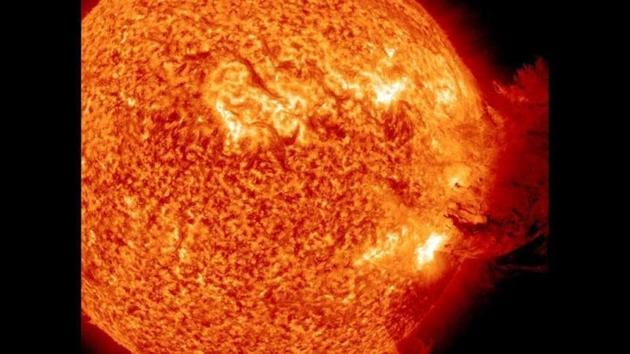Sun’s behavior to change from 2020. This is how it will help space missions
According to scientists, predicting the solar cycle is important because the sun’s activity influences environmental conditions in the space. This adversely affects satellites and space-based technologies such as telecommunications and navigational networks.
Indian scientists have come up with the first physics-based prediction of the upcoming solar cycle — also called sunspot cycle — scheduled to start early in 2020. The prediction revealed how the sun will behave and the expected conditions in space over the next decade, which will help in strategically plan missions to space and in the upkeep of space-based technologies.

Every 11 years, the sun’s magnetic field flips because the north and south poles switch places, which marks the beginning of a new solar cycle. The solar cycle affects the activity on the surface of the sun such as sunspots, which are caused by the sun’s magnetic fields. When the magnetic field lines near sunspots tangle, cross, or reorganize, it can lead to an explosion of energy called a solar flare that can cripple satellites, trip electric power grids and lead to large-scale telecommunication breakdowns.
Combining magnetic field evolution models for the sun’s surface and interior, a two-member team from the Centre of Excellence in Space Sciences India at the Indian Institute of Science Education and Research, Kolkata, performed the first century-scale data-driven simulations of solar activity — coupling for the first time two different models of the Sun. The study ‘Prediction of the strength and timing of sunspot cycle 25 reveal decadal-scale space environmental conditions’ co-authored by PhD student Prantika Bhowmik was published in the journal Nature Communications on Thursday.
The research was supported by the Ministry of Human Resource Development, Government of India, Indo-French Centre for the Promotion of Advanced Research and NASA.
Their forecast reveals that the next solar cycle 25 will be similar to the current cycle 24, which will end in December 2019 The next cycle might be slightly stronger that the previous cycle and will peak around 2024. The current solar cycle 24 is one of the weakest cycles in the century.
“Predicting the solar cycle is therefore important because the sun’s activity influences environmental conditions in the space. This adversely affects satellites and space-based technologies such as telecommunications and navigational networks,” said professor Dibyendu Nandi, lead investigator.
Nandi, also an associate at the Pune-based Inter-University Centre for Astronomy and Astrophysics (IUCAA) added, “The Sun is also the primary natural source of energy for the earth’s climate. The sun’s activity level changes but predicting these changes has been challenging.”
With India slated to launch its maiden mission to the Sun — Aditya L1 — in 2020 that will study various aspects of the Sun and space-weather, Somak Raychaudhary, director of IUCAA said, “This is a very important paper because it looks like we will now be able to predict fluctuations of solar activity much more reliably. Predicting how the sun will behave will help in the satellite launch. Data from observing the Sun from Aditya L1 will also help the research team to make their models better.”
Till now, there was five-year window to predict the future occurrence and performance of the next solar cycle before the end of a current cycle based on statistical modelling. However, the margin of error was high.
While the peaks of some solar cycles are stronger — between 150 and 200 sunspots — there are also those weaker than average – below 100 sunspots. Researchers said successive solar cycles over the last several decades have significantly weakened in strength leading to a widespread speculation that a significantly weak sunspot cycle 25 or an impending disappearance of sunspots for many decades such as one between 1645 and 1715 would alleviate global warming and bring down the Earth’s temperature.
However, the team said the solar cycle 25 will not be insignificant, and predict that space environmental conditions over the next decade would be similar or slightly harsher compared to the last decade.
“There is no evidence of an impending disappearance of sunspot cycles. Speculation of an imminent sun-induced cooling of global climate is very unlikely, and therefore countries will have to work towards keeping global temperatures from rising,” said Nandi.






